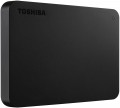— SATA. Nowadays, it is the most popular interface for connecting internal hard drives.
the first version of SATA provides data transfer rates of about 1.2 Gbps,
SATA 2 has a practical data transfer rate of about 2.4 Gbps (300 MB / s), and the most advanced generation of
SATA 3 has a speed of 4.8 Gbps (600 Mbps)
eSATA. Modification of the SATA interface, designed to connect external hard drives; not compatible with internal SATA. The practical data transfer rate is similar to SATA 2 at about 2.4 Gbps (300 Mbps).
—
USB 2.0. The earliest of the USB standards found in modern hard drives — and exclusively external (see "Performance"). Provides connection to a traditional full-size USB port, provides data transfer rates up to 480 Mbps, as well as a rather low power supply, which is why drives with this type of connection often require additional power. In light of all this, and the advent of the more advanced USB 3.2 standard (see below), USB 2.0 is considered obsolete today and is extremely rare, mainly in inexpensive and early models of drives. However, a drive with this interface can also be connected to a newer USB port — the main thing is that the connectors match.
—
USB 3.2 gen1(previously USB 3.1 gen1 and USB 3.0). The standard for connecting external HDDs, which replaced the
...USB 2.0 described above. Uses a traditional full-size USB connector, delivers data transfer speeds up to 4.8 Gbps (600 Mbps) and higher power ratings, making these drives easier to handle without external power. However, for the same reason, you need to be careful when connecting USB 3.2 gen1 drives to older USB 2.0 connectors — such a connector may not have enough power to power a newer drive.
— USB 3.2 gen2. Further development of the USB 3.2 standard (formerly known as USB 3.1 gen2 and USB 3.1). The maximum data transfer rate in this version has been increased to 10 Gbps, and the power supply can reach 100 W (supporting USB Power Delivery technology). At the same time, drives with this type of connection can also work with earlier versions of full-size USB connectors — the main thing is that there is enough power.
— USB-C 3.2 gen1(formerly USB-C 3.1 gen1 and USB-C 3.0). USB Type-C connection compliant with USB 3.2 gen1 capabilities. These features are described in more detail above, the difference from the “regular” USB 3.2 gen1 in this case lies only in the type of connector: this is a relatively small (slightly larger than microUSB) socket, which also has a double-sided design. Due to its compact size, USB-C is found both in full-sized PCs and laptops, and in compact gadgets like smartphones and tablets; some drives with this connection are initially capable of "mobile" use.
— USB-C 3.2 gen2(formerly USB-C 3.1 gen2 and USB-C 3.1). Updating and improving the USB-C 3.2 gen1 described above — the same USB-C connector and increased data transfer rate to 10 Gbps (as in the "regular" USB 3.2 gen2).
— IEEE 1394. Also commonly known as "FireWire". A universal connector, similar in capabilities to USB 2.0 (see above), but used much less often, and nowadays is practically obsolete.
— Thunderbolt. High-speed interface for connecting external peripherals. It is used mainly in Apple computers and laptops, although it is also found in equipment from other manufacturers. Note that in modern HDDs there are mainly two versions of Thunderbolt, which differ not only in speed, but also in connector: Thunderbolt v2(up to 20 Gbps) uses a miniDisplayPort plug, and Thunderbolt v3(up to 40 Gbps) — USB type C plug (see above). Thus, in some hard drives, USB-C and Thunderbolt connections are implemented through a single hardware connector, which automatically detects which computer input the device is connected to.
— S.A.S. Modification of the SCSI interface, provides data transfer rates up to 6 Gbps (750 Mb / s). It is used mainly in servers, in desktop PCs and laptops it is practically not used.
— Fibre Channel. Professional high-speed interface primarily used in server drives ("Purpose"); similar in many ways to SAS. Allows "hot" replacement of drives; the actual data transfer rate over Fibre Channel, depending on the version, can reach 12.8 Gbps.
